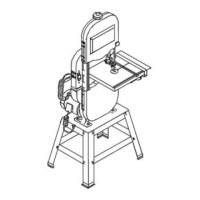round work properly (with a V-block or
clamped to the miter gauge) to prevent it from rolling
and the blade from biting.
only one work-piece at a time. Make sure the
table is clear of everything except the work-piece
and its guides before you turn the saw on.
the saw run before each use. If
there is excessive vibration or unusual noise, stop
immediately. Turn the saw OFF. Unplug it
immediately. Do not start the saw again until the
problem has been located and corrected.
any jammed material, turn the switch OFF.
Remove the switch key and unplug the saw. Wait
for all moving parts to stop before removing jammed
the work area until all moving parts
are stopped. To child-proof the workshop, shut OFF
the power to master switches and remove the switch
key from the band saw. Store it in a safe place,
For your own safety, read the entire instruction manual
before operating the band saw.
2. Do not wear gloves, necktie, or loose clothing.
3. Make sure the saw is on a fi rm level surface and
USE ONLY THE RECOMMENDED ACCESSORIES.
5. Use extra caution with very large, very small, or
6. Keep hands away from the blade at all times to
prevent accidental injury.
7. Do not remove jammed cutoff pieces until the blade
8. Maintain proper adjustment of blade tension, blade
guides and thrust bearings.
9. Adjust upper guide to just clear the work-piece
10. Hold the work-piece fi rmly against the table.
from unexpected movement,
make sure the saw is on a fi rm, level surface,
roperly secured to prevent rocking. Make sure there
is adequate space for operating. Bolt the saw to
a support surface to prevent slipping, walking, or
sliding during operation.
and unplug the saw before
blades rated at 2700 FPM or greater.
the blade teeth point down and
BLADE GUIDES, SUPPORT BEARINGS, AND
must be properly adjusted to
avoid accidental blade contact and to minimize
blade breakage. To maximize blade support, always
adjust the upper blade guide and blade guard so
that it is 1/8 inch above the work-piece.
with large, very small or
from sliding off the table top. Never use another
person to support the work-piece.
must be secured so they don’t twist,
rock, or slip while being cut.
intricate and small work carefully to avoid
pinching the blade. Avoid awkward operation and
hand positions to prevent accidental contact with the
should be secured with jigs or
fi xtures. Do not hand hold pieces that are so small
your fi ngers are under the blade guard.

